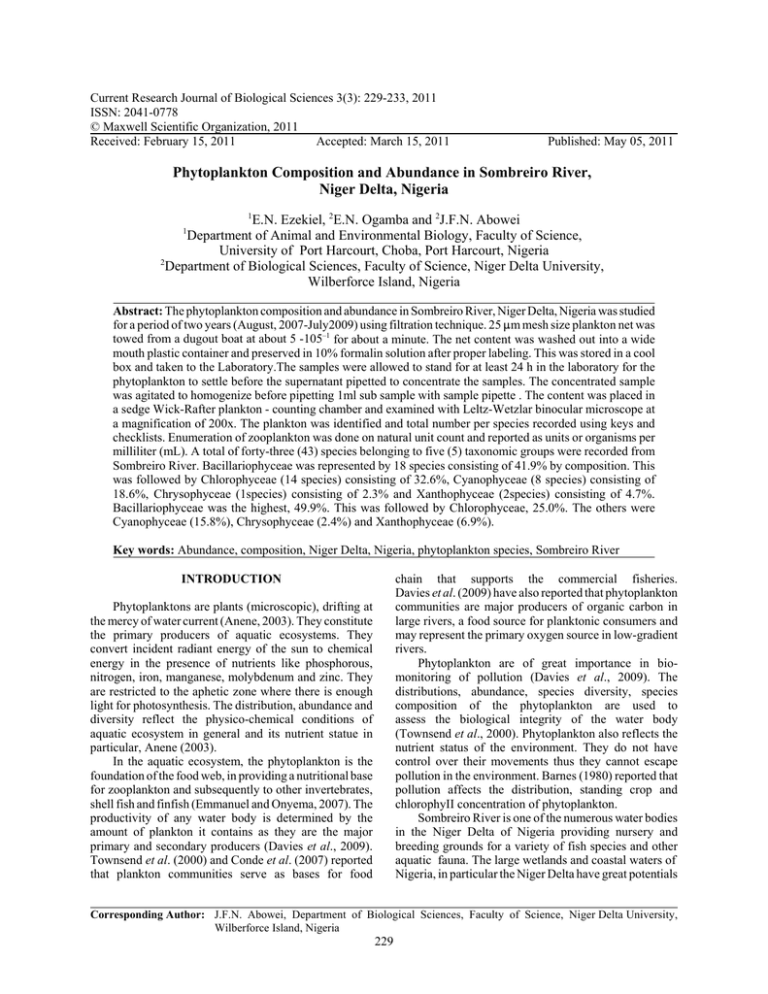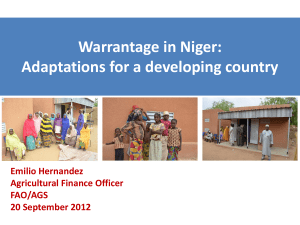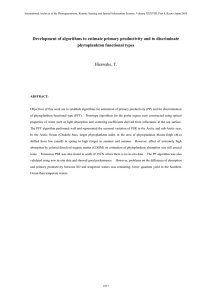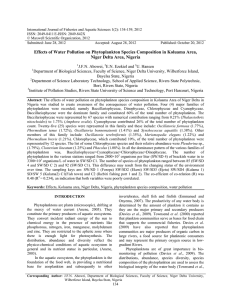Current Research Journal of Biological Sciences 3(3): 229-233, 2011 ISSN: 2041-0778
advertisement

Current Research Journal of Biological Sciences 3(3): 229-233, 2011 ISSN: 2041-0778 © Maxwell Scientific Organization, 2011 Received: February 15, 2011 Accepted: March 15, 2011 Published: May 05, 2011 Phytoplankton Composition and Abundance in Sombreiro River, Niger Delta, Nigeria 1 E.N. Ezekiel, 2E.N. Ogamba and 2J.F.N. Abowei Department of Animal and Environmental Biology, Faculty of Science, University of Port Harcourt, Choba, Port Harcourt, Nigeria 2 Department of Biological Sciences, Faculty of Science, Niger Delta University, Wilberforce Island, Nigeria 1 Abstract: The phytoplankton composition and abundance in Sombreiro River, Niger Delta, Nigeria was studied for a period of two years (August, 2007-July2009) using filtration technique. 25 :m mesh size plankton net was towed from a dugout boat at about 5 -105–1 for about a minute. The net content was washed out into a wide mouth plastic container and preserved in 10% formalin solution after proper labeling. This was stored in a cool box and taken to the Laboratory.The samples were allowed to stand for at least 24 h in the laboratory for the phytoplankton to settle before the supernatant pipetted to concentrate the samples. The concentrated sample was agitated to homogenize before pipetting 1ml sub sample with sample pipette . The content was placed in a sedge Wick-Rafter plankton - counting chamber and examined with Leltz-Wetzlar binocular microscope at a magnification of 200x. The plankton was identified and total number per species recorded using keys and checklists. Enumeration of zooplankton was done on natural unit count and reported as units or organisms per milliliter (mL). A total of forty-three (43) species belonging to five (5) taxonomic groups were recorded from Sombreiro River. Bacillariophyceae was represented by 18 species consisting of 41.9% by composition. This was followed by Chlorophyceae (14 species) consisting of 32.6%, Cyanophyceae (8 species) consisting of 18.6%, Chrysophyceae (1species) consisting of 2.3% and Xanthophyceae (2species) consisting of 4.7%. Bacillariophyceae was the highest, 49.9%. This was followed by Chlorophyceae, 25.0%. The others were Cyanophyceae (15.8%), Chrysophyceae (2.4%) and Xanthophyceae (6.9%). Key words: Abundance, composition, Niger Delta, Nigeria, phytoplankton species, Sombreiro River chain that supports the commercial fisheries. Davies et al. (2009) have also reported that phytoplankton communities are major producers of organic carbon in large rivers, a food source for planktonic consumers and may represent the primary oxygen source in low-gradient rivers. Phytoplankton are of great importance in biomonitoring of pollution (Davies et al., 2009). The distributions, abundance, species diversity, species composition of the phytoplankton are used to assess the biological integrity of the water body (Townsend et al., 2000). Phytoplankton also reflects the nutrient status of the environment. They do not have control over their movements thus they cannot escape pollution in the environment. Barnes (1980) reported that pollution affects the distribution, standing crop and chlorophyII concentration of phytoplankton. Sombreiro River is one of the numerous water bodies in the Niger Delta of Nigeria providing nursery and breeding grounds for a variety of fish species and other aquatic fauna. The large wetlands and coastal waters of Nigeria, in particular the Niger Delta have great potentials INTRODUCTION Phytoplanktons are plants (microscopic), drifting at the mercy of water current (Anene, 2003). They constitute the primary producers of aquatic ecosystems. They convert incident radiant energy of the sun to chemical energy in the presence of nutrients like phosphorous, nitrogen, iron, manganese, molybdenum and zinc. They are restricted to the aphetic zone where there is enough light for photosynthesis. The distribution, abundance and diversity reflect the physico-chemical conditions of aquatic ecosystem in general and its nutrient statue in particular, Anene (2003). In the aquatic ecosystem, the phytoplankton is the foundation of the food web, in providing a nutritional base for zooplankton and subsequently to other invertebrates, shell fish and finfish (Emmanuel and Onyema, 2007). The productivity of any water body is determined by the amount of plankton it contains as they are the major primary and secondary producers (Davies et al., 2009). Townsend et al. (2000) and Conde et al. (2007) reported that plankton communities serve as bases for food Corresponding Author: J.F.N. Abowei, Department of Biological Sciences, Faculty of Science, Niger Delta University, Wilberforce Island, Nigeria 229 Curr. Res. J. Biol. Sci., 3(3): 229-333, 2011 for commercially important fishery (Powell et al., 1985). The Niger Delta is the richest part of Nigeria in terms of natural resources with large deposits of petroleum products (Moffat and Linden, 1995; Braide et al., 2004). Similarly, the vast coastal features which include forest swamps, mangrove, marsh, beach ridges, rivers, streams and creeks serve as natural habitats for various species of flora and fauna (Alaibo, 1988; Jamabo, 2008). The stretch of the Sombreiro River is one of the most important river systems in the Niger Delta providing nursery and breeding grounds for a large variety of fish species (Ezekiel et al., 2002). Research into the composition an abundance of phytoplankton in Sombreiro River is aimed at providing baseline data to compliment existing data and determine their occurrence in natural conditions for management decision in the management of the fishery. transportation. These may be potential sources of pollution to the environment. Public toilets were observed at each of the sampling stations. Also observed were refuse dumps and run-offs into the river from the rivernie communities. The wastes from the comities may constitute source of pollution to the river. Four sampling stations were established along the length of Sombreiro River. Stations were chosen in a such a manner to provide for even spread for effective sampling. Each of the stations was visited once a month, usually between the 15th and 22nd. Photographs were taken of each station to illustrate the habitat. Only qualitative description of stations were made in order to classify the stations according to general habitat types. The four stations investigated in this study are described below on the basis of personal visual observations. Station 1 (Degema): This is the largest of all the sampling stations. The vegetation fringing the river at the left and right banks consists of mangrove plants such as Rhizophora, Avicennia and Nypha Fruticans (Nypa palm), arising from a characteristic muddy substrate that produces a foul odor. The water is highly turbid in the rainy months and clear in the dry months. This station is a brackish and tidal environment. There is no observable unidirectional flow of the water at this station due to the very wide nature of the river; thus the surface current is not very distinct to be determined. The bed of the river at this station is a mosaic mud and sand. No farmland was observed at this station but there were public toilets which discharge human wastes directly into the river. MATERIALS AND METHODS Study area: The study was carried out in Sombreiro River, in the Niger Delta of Nigeria for a period of two years (August, 2007-July, 2009). It is one of the rivers that drains the western part of Rivers State. The river provides nursery and breeding grounds for a large variety of fish species (Ezekiel et al., 2002). Four sampling stations were established along the length of the Sombreiro River whenever, it was accessible by road . Sombreiro River is located in three local government areas of Rivers stale - Ogba/Egbema/Ndoni and Degema between Latitude 6º30! and 7º0! E and Longitude 4º12! and 6º17! N. It is a distributary of the River Niger which arises from northern boundary of Rivers State with Imo State. it is one of the series of the Niger Delta rivers which drain into the Atlantic Ocean and is connected to other rivers via creeks in the coastal area of the Niger Delta (Ezekiel, 1986, 2001) . The river is narrow and steep as it flows southwards, it widens and the steep sidedness gradually disappears starting from the middle reaches. The system is lotic throughout the year; the lotic period reaches its peak in January to February (dry season) when the water level has fallen to the maximum. In August - September (wet season), the lotic nature of the river is reduced due to flooding (Ezekiel, 1986). The river is contained within the tropical rainforest although the lower reach is within the brackish mangrove zone. From upstream the river bed consists of stones and gravels, the middle zone tending to be sandy with the sand bed giving way to a muddy one at the lower reach of the river (Ezekiel, 1986). A part from areas of human disturbance, the river is fringed by riverine forest. Numerous human activities such as fishing, sand nuning, dredging, mangrove cutting, logging of timber and Station 2 (Ogbele): At station 2, mangrove vegetation is replaced by riverine forest consisting mainly of Raphia, Pandanus, Sanderiana, Calamas sp. (swamp cane), Khaya sp. (Mahogany), Vapaca sp., Ficus Vogeliana and Triculia african. Aquatic marcophytes include Nymphace sp., Eichornia crassipes, Sagittana sp., Pistia stratictes. The station was flooded in the rainy season when the current velocity is slow. The station has a little tidal influence from the immediate tidal mangrove zone. The bed of the river at this station consists of sand and small gravel. No farmland was noticed but there were public toilets which discharge human wastes directly into the river. Station 3 (Ihuaba): The vegetation fringing the river at this station is a mixture of riverine and terrestrial vegetation although no farmland was seen. The common plants noticed here are the Raphia and Elaeis guineensis (palm trees). The aquatic macrophytes include Typha lotifolia (cat tail) and Potamogetom sp (pond weed). The station was flooded from August to October with the flood receding from November to February. The speed of 230 Curr. Res. J. Biol. Sci., 3(3): 229-333, 2011 Table 1: Phytoplankton species in Sombreiro River, Niger Delta, Nigeria S.No. Taxonomic group Genus/species Bacillariophyceae 1. Melosira granulata 2. Melosira varians 3. Melosira distance 4. Melosira pusilla 5. Navicula viridula 6. Nitzschia sigma 7. Cyclotella operculata 8. Cyclotella omta 9. Cosinodiscus lacustris 10. Cymbella lata 11. Fragilaria intermedia 12. Gyrosigma acuminatum 13. Pinnularia horealis 14. Amphora ovalis 15. Synedra affinis 16. Synedra ulna 17. Stephanodiscus asroea 18. Tabellaria fenestrata Chlorophyceae 19. Volvox aureus 20. Volvox globator 21. Coelastrum reticulata 22. Closterium intermedium 23. Closterium pervulum 24. Clostrium gracile 25. Crusigenia puadrata 26. Crusigenia truncata 27. Netrium digitatus 28. Netrium intermedium 29. Gonatozygon aculeatum 30. Spirogyra sp 31. Spirotaenia condensata 32. Desmidium sp Cyanophyceae 33. Anabaena spiroides 34. Anabaena affinis 35. Anabaena arnoldii 36. Oscillatoria lacustris 37. Oscilartoria princeps 38. Raphidiopsis mediteranea 39. Rivularia sp. 40. Lynbya limnetica Chrysophyceae 41. Dinobryon sertularia Xanthophyceae 42. Tribonema minus 43. Tribonema viridis the current is slow in the rainy season. The bottom of the river at this station consists of sand and gravel of various sizes. No farmland was observed but there were public toilets which discharge human waste into the river. Station 4 (Odiemudie): The vegetation consists of a terrestrial vegetation in which can be seen farmland, and riverine vegetation extending into a large area of swamps. Some include Raphia, Pandanus Sanderiana Elaeis guineensis (palm trees) Aquatic macrophytes include/ Pomea aquatica, Lemna sp. (duck weed), Utricularia sp., Nympaea sp. and Pistia stratiotes (water lettuce). Current is moderate in the rainy months, becoming fast in the dry months when the flood recedes. The water is clear and the bottom consists of small stones, gravel of various sizes and sand. Sample collection: In each of the sampling stations zooplankton samples were collected. phytoplankton was collected by filtration technique. 25 :m mesh size plankton net was towed from a dugout boat at about 5 105 –1 for about a minute. The net content was washed out into a wide mouth plastic container and preserved in 10% formalin solution after proper labeling. This was stored in a cool box and taken to the Laboratory (APHA, 1998) The samples were allowed to stand for at least 24 h in the laboratory for the phytoplankton to settle before the supernatant pipetted to concentrate the samples. The concentrated sample was agitated to homogenize before pipetting 1ml sub sample with sample pipette (ibid). The content was placed in a sedge Wick-Rafter plankton counting chamber and examined with Leltz-Wetzlar binocular microscope at a magnification of 200x (APHA, 1998). The plankton was identified and total number per species recorded using keys and checklists of Hutechinson (1967). Enumeration of zooplankton was done on natural unit count and reported as units or organisms per mL (APHA, 1998). RESULTS The phytoplankton species recorded during the study are presented in Table 1 and 2. A total of forty-three (43) species belonging to five (5) taxonomic groups were recorded from Sombreiro River. Bacillariophyceae was represented by 18 species consisting of 41.9% by composition. This was followed by Chlorophyceae (14 species) consisting of 32.6%, Cyanophyceae (8 species) consisting of 18.6%, Chrysophyceae (1 species) consisting of 2.3% and Xanthophyceae (2 species) consisting of 4.7%. Figure 1 shows the group abundance of individuals in Sombreiro River. Bacillariophyceae was the highest, 49.9%. This was followed by Chlorophyceae, Table 2: Number and percentage compositions of Phytoplankton families in Sombreiro River Percentage species Taxonomic group Total no. of species composition Bacillariophyceae 18 41.9 Chlorophyeae 14 32.6 Cyanophyceae 8 18.6 Chrysophyceae 1 2.3 Xanthophyceae 2 4.7 Total 43 100 25.0%. The others were Cyanophyceae (15.8%), Chrysophyceae (2.4%) and Xanthophyceae (6.9%). 231 Curr. Res. J. Biol. Sci., 3(3): 229-333, 2011 Percentage abundance 52 39 26 13 0 Bacillariophceae Cyanophcea Xanthophyceae Chlorophyceae Chrysophyceae Phytoplankton Fig. 1: Taxonomic group abundance of Phytoplankton in Sombreiro river (August 2007-July 2009) The dominance of Bacillariophyceae in this study is not an unusual occurrence. Many phytoplankton studies have reported the dominance of Bacillariophyceae in rivers and creeks of the Niger Delta and Nigeria. Such reports include Yakubu et al. (2000), Ogamba et al. (2004), Emmanuel and Onyema (2007), Abowei et al. (2008), Zabbey et al. (2008), Davies et al. (2009), Nkwoji et al. (2010) and Margalef (1963) had reported that species with the highest self-sustaining natural mechanisms of natural increase usually become dominant. This may account with the widespread dominance of Bacillariophyceae in both fresh and brackish waters. DISCUSSION Forty-three species belonging to 5 taxonomic groups were recorded in the study area. The phytoplankton composition was dominated by Bacillariophceae (diatoms) with 18 species (41.9%). Chlorophyceae had 14 species consisting of 32.6%. Cyanophyceae had 8 species consisting of 18.6%. The other were Xanthophceae (2 species) and Chrysolpheae (1 specie) consisting of 4.7 and 2.3%, respectively. This result is higher than the reports from some Niger Delta rivers. Yakubu et al. (2000) recorded 17 species from Rivers River Nun. Yakubu et al. (2000) also observed 20 and 34 species from Orashi and Nkisa Rivers respectively while Erondu and Chinda (1991) reported 27 species from New Calabar River. However, the result of this study is lower than the reported 103 species from Imo River by Zabbey et al. (2008). This result compared favourably with the reported 39 species in Lubara Creek by Abowei et al. (2008) and 36 species of phytoplankton from the Lagos Lagoon by Nkwoji et al. (2010). The result of this study, however, varies considerably from some other studies in Nigeria. Ogamba et al. (2004) reported 143 species in Elechi creek. Davies et al. (2009) recorded 169 species in Elechi Creek and Emmanuel and Onyema (2007) reported 82species in Lagos Lagoon. Furthermore, Edogbolu and Aleleye-Wokoma (2007) reported 198 species from Ntawogba Creek, Port Harcourt. Phytoplankton abundance is influenced by water temperature, velocity of current, availability of nutrient and light penetration into the water. Yakubu et al. (1998) attributed influence of lotic environment to the difference of total number of species recorded in Nun River. CONCLUSION C C C C C Forty-three species belonging to 5 taxonomic groups were recorded in the study area. The phytoplankton composition was dominated by Bacillariophceae (diatoms) with 18 species (41.9%). The dominance of Bacillariophyceae in this study is not an unusual occurrence. Chlorophyceae had 14 species consisting of 32.6%. Cyanophyceae had 8 species consisting of 18.6%. Xanthophceae (2 species) and Chrysolpheae (1 specie) consisting of 4.7 and 2.3%, respectively. The results compared favourably with some similar reports and varied with others. ACKNOWLEDGMENT We are grateful to University of Port Harcourt and all that assisted us in one way or the other in this study. However, to God is the Glory. 232 Curr. Res. J. Biol. Sci., 3(3): 229-333, 2011 REFERENCES Ezekiel, E.N., 2001. Comparative studies of the flood plains and major Rivers in Odiokwu - Ekpeye, Niger Delta. M.Sc. Thesis, University of Port Harcourt. Choba, pp: 77. Ezekiel, E.N., J.F.N. Abowei and A.I. Hart, 2002: The Fish Species Assemblage of Odiokwu-Ekpeye Flood Plains, Niger Delta. Int. J. Sci. Tech., 1(1): 54-59. Hutechinson, G.E., 1967. Thoughts on aquatic insects. Bio-Science, 31: 495-500. Jamabo, N.A., 2008. Ecology of tympanotonus fuscatus (Linnaeus, 1758) in the mangrove swamps of the upper Bonny River, Niger Delta, Nigeria. Ph.D. Thesis, Rivers State University of Science and Technology, Port Harcourt, Nigeria, pp: 231. Margalef, R., 1963. On certain unifying principles in ecology. An. Nat., 97: 357-374. Moffat, D. and O. Linden, 1995. Perception and reality: Assessing priorities for sustainable development in the Niger River Delta. Ambio, 24(7-8): 529-538. Nkwoji, J.A., I.C. Onyema and J.K. Igbo, 2010. Wet season spatial occurrence of phytoplankton and zooplankton in Lagos Lagoon, Nigeria. Sci. World J., 5(5): 7-14. Ogamba, E.N., A.C. Chinda, I.K.E Ekweozor and J.N. Onwuteaka, 2004. Water quality and phytoplankton distribution in Elechi Creek Complex of the Niger Delta. J. Nigerian Environ. Soc., (JNES), 1(2): 121-130. Powell, C.B., S.A. White, D.O. Ibiebele, M. Bara, B. Dutkiewics, M. Isoun and F.U. Oteogbu, 1985. Oshika Ail Spillage Environmental Impact; Effect on Aquatic Biology. Paper Presented at NNPC/FMIFC International Seminar on Petroleum Industry and the Nigerian Environment, 11-13 Nov., in Kaduna, Nigeria, pp: 168-178. Townsend, C.R., J.D. Harper and M. Begon, 2000. Essentials of Ecology. 3rd Edn., Blackwell Science. London, U.K. Yakubu, A.F., F.D. Sikoki and J.R.H. HorsfalI, 1998. An investigation into the physico-chemical conditions and planktonic organisms of the lower reaches of the Nun River, Nigeria. JASEM, 1(1): 38-42. Yakubu, A.F., F.D. Sikoki, J.F.N. Abowei and S.A. Hart, 2000. A comparative study of phytoplankton communities of some Rivers, Creeks and burrow pits in the Niger Delta. Area. J. Appl. Sci. Environ. Manage., 4(2): 41-46. Zabbey, N., F.D. Sikoki and J. Erondu, 2008. Plankton assemblages and environmental gradients in the middle reaches of the Imo River, Niger Delta, Nigeria. Afr. J. Aquat. Sci., 33(2): 241-248. Abowei, J.F.N., C.C. Tawari., A.I. Hart and D.U. Garricks, 2008. Fin fish species composition, abundance and distribution in the Lower Sombreiro River, Niger Delta, Nigeria. Int. J. Trop. Agric. Food Sys., 2(1): 46-43. Alaibo, O.O., 1988. The fisheries resource exploitation of the bonny/ new calabar esturine fishing ground in the Niger Delta. M.Phil. Thesis, Rivers State University of Science and Technology, Port Harcourt, pp: 111. Anene, A., 2003. Techniques in Hydrobiology In: Eugene, N.O. and O.O. Julian, (Eds.), Research Techniques in Biological and Chemical Sciences. Springfield Publishers, pp: 174-189. APHA, AWWA, WEF, 1998, Standard Methods for the Examination of Water and Waste Water. 18th Edn., Greenberg, A.E., L.S. Clesceri and A.D. Eaton, (Eds.), America Public Health Association, American Water Works Association, Water Environment Federation. Barnes, R.S.K., 1980. Coastal Lagoons. 2nd Edn., Cambridge University Press, London, U.K., pp: 106. Braide, S.A., W.A.L. Izonfuo, P.U. Adakwu, A.C. Chinda and C.C. Obinwo, 2004. Water quality of miniweja stream, a swamp forest stream receiving non-point source waste discharge in Eastern Niger Delta, Nigeria. Sci. Afric., 3(1): 1-8. Conde, D., S. Bonita, L. Aubriot, R. De Leon and W. Pintos, 2007. Relative contribution of planktonic and benthic microalgae production in a Eutrophic Coastal Lagoon of South America. J. Limnol., 78: 207-212. Davies, O.A., J.F.N. Abowei and C.C. Tawari, 2009. Phytoplankton community of Elechi Creek, Niger Delta, Nigeria - A nutrient polluted tropical creek. Am. J. Appl. Sci., 6(6): 1143-1152. Edogbolu, A.J. and I.P. Aleleye-Wokoma, 2007. Seasonal Variations in Phytoplankton Composition and Physicochemical Properties of Ntawoba Creek, Port Harcourt, Nigeria. Emmanuel, B.E. and I.C. Onyema, 2007. The plankton and fishes of a tropical creek in South Western Nigeria. Turk. J. Fish. Aquat. Sc., 7: 105-113. Erondu, E.S. and A.C. Chinda, 1991. Variations in the physicochemical features and phytoplankton of new Calabar River at Aluu, Rivers State, Nigeria. Nigerian Institute of Oceanography and Marine Research, Tech, Paper No. 75: 3-18. Ezekiel, E.N., 1986. Longitudinal Zonation of Ichthyofauna of the River Sombreiro, Rivers State. B.Sc. Project Rivers State University of Science and Technology, Port Harcourt, pp: 74. 233









